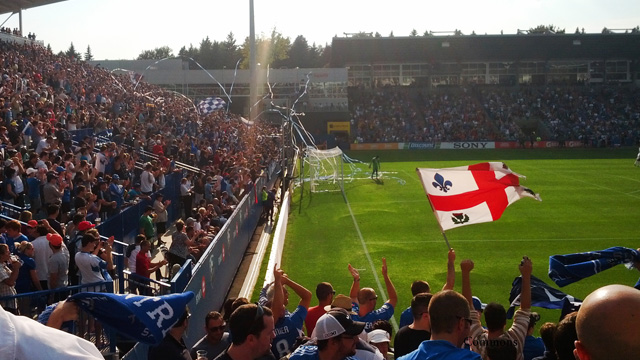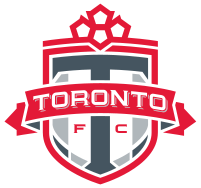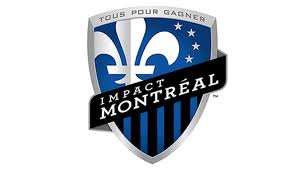MLS and the Two Solitudes: “Rivalry Week” with a side of Canadian history

By Elizabeth Cotignola, Special to SoccerWire.com
 Author’s note: Certain portions of this text were incorporated in a similar piece which appeared on A Football Report in 2012.
Author’s note: Certain portions of this text were incorporated in a similar piece which appeared on A Football Report in 2012.
The beautiful game incites passion like few other things on earth. This passion is often expressed most vociferously within the context of the game’s most revered rivalries. This week is MLS Rivalry Week, when the league will showcase five matchups meant to represent the fiercest matchups MLS has to offer.
When Toronto FC joined Major League Soccer back in 2007, the Columbus Crew, one of the league’s 10 charter members, was designated their primary rival. This manufactured-for-MLS rivalry was largely a conflict of convenience, a function of the lack of any other team in closer proximity to Canada’s largest city and the fact that the Reds’ most ardent supporters required a destination for road trips.
 The rivalry served its purpose in those early years. In 2009, some actual animosity was injected into the previously placid liaison when a post-game melee led to 20 Columbus Police Department cruisers arriving on scene, a tasering and some arrests – a rare display of rambunctiousness, indeed, for the usually unfailingly polite Canadians.
The rivalry served its purpose in those early years. In 2009, some actual animosity was injected into the previously placid liaison when a post-game melee led to 20 Columbus Police Department cruisers arriving on scene, a tasering and some arrests – a rare display of rambunctiousness, indeed, for the usually unfailingly polite Canadians.
But in general, Torontonians have nothing against the good people of Columbus. As far as rivalries go, that’s a tad problematic. A competition which derives its moniker from a pretty plant – the teams compete for the Trillium Cup, named for the official flowers of Ontario and Ohio – requires a certain degree of effort to be excited about.
But now, things have changed: enter the Montreal Impact. MLS’ third Canadian franchise hails from the one city Torontonians love to hate most. The rivalry between these two cities has been manifested multiple times before: between the Argos and the Alouettes of the CFL, baseball’s Blue Jays and the now-defunct Expos, and, most importantly, in the nation’s oldest sporting rivalry: that between the NHL’s Maple Leafs and les Canadiens de Montréal.
The roots of this rivalry run deep. From 1944 to 1978, the Maple Leafs and the Canadiens met each other in the Stanley Cup playoffs 12 times and faced off in five finals. While the competition on-ice is fierce, this rivalry is actually symbolic of a much deeper cultural cleavage in Canadian society. It is merely a manifestation of the historical enmity that has existed between English and French Canadians since Canada’s formation.
Make no mistake, though fans of other franchises may argue otherwise: This is the league’s most compelling rivalry. How could it not be, when it embodies a country’s entire history?
The rivalry between the Impact and TFC – and by extension, between the cities of Montreal and Toronto – approximates the politically charged animosities more often found among Europe’s clubs, such as that between Culés and Madridistas in Spain, than it does the geographical rivalries that have formed in MLS. From the time of the British defeat of Québec at the Plains of Abraham in 1759, the chief tension in what would eventually become the country of Canada has been that between English- and French-speaking Canadians.
 Historically, English Canadians were for the most part of British ethnic stock and Protestant, associated with and loyal to the British Crown. In contrast, French Canadians, known as the Québecois, were of French descent, heavily Roman Catholic, and did not look upon the British monarchy fondly – to put it lightly.
Historically, English Canadians were for the most part of British ethnic stock and Protestant, associated with and loyal to the British Crown. In contrast, French Canadians, known as the Québecois, were of French descent, heavily Roman Catholic, and did not look upon the British monarchy fondly – to put it lightly.
Centuries later, in the October Crisis of 1970, the Front de libération du Québec, a terrorist group bent on sovereignty for the province, would hold the city of Montreal hostage with a rash of bombings and kidnappings, part of an idealist war they waged against what they perceived to be imperialist Anglo-Saxon oppression: the continued influence of the British Crown.
When the NHL was created in 1917, these differences continued to play themselves out – on a much less violent basis – in the rivalry between the Maple Leafs and Canadiens – the oldest rivalry in the history of the National Hockey League. The Maple Leafs’ fanbase consisted primarily of English-speaking Canadians of British descent. In fact, the team’s logo from 1927 onward was a stylized version of the insignia sported by the Canadian Army (who fought on behalf of the British crown) during World War I.
As late as the 1970s, a portrait of Queen Elizabeth II, Canada’s official head of state, hung in the Leafs’ home arena, Maple Leaf Gardens, and “God Save the Queen,” the royal anthem, was the song of choice before any game. The Canadiens, meanwhile, captured the imaginations of Canada’s French-speaking population, mainly concentrated in the province of Québec. It was the Habs, as they are affectionately known, who pioneered the use of what is now Canada’s national anthem, “O Canada,” at that mecca of hockey, the Montreal Forum (albeit with bilingual lyrics as opposed to the entirely English version used throughout the rest of Canada).
 Canada’s greatest rivalry was particularly acute during the 1960s, as one of the two teams would capture the Stanley Cup each year of the decade, with the exceptions of 1961 and 1970. The rivalry reached its zenith in the 1967 season, when both teams met in the Stanley Cup Finals during the centennial year of Canadian Confederation. The city of Montreal was hosting Expo 67 that year, and the Canadiens were expected to beat the Leafs with ease. Yet Toronto, the underdog, upset the Habs to capture Canada’s most coveted piece of silverware.
Canada’s greatest rivalry was particularly acute during the 1960s, as one of the two teams would capture the Stanley Cup each year of the decade, with the exceptions of 1961 and 1970. The rivalry reached its zenith in the 1967 season, when both teams met in the Stanley Cup Finals during the centennial year of Canadian Confederation. The city of Montreal was hosting Expo 67 that year, and the Canadiens were expected to beat the Leafs with ease. Yet Toronto, the underdog, upset the Habs to capture Canada’s most coveted piece of silverware.
This rivalry resumes tonight, under the auspices of MLS, when the Reds host their familiar foes in what has been dubbed the “401 Derby,” after the stretch of highway that links the cities, by some. Coincidentally, this fixture will take place on the night of la Fête de la Saint Jean – or la Fête Nationale, depending on one’s political leanings – Quebec’s national holiday, which is probably the most politically charged day on Quebec’s calendar.
It is doubtful that the MLS brass contemplated Canadian political history when tabling the season’s schedule, but the symbolism of this matchup, on this day, gives its Rivalry Week a whole new meaning.
Simply stated, Montreal and Toronto hate each other. They always have, and they always will. This is a good thing. If the beautiful game is to continue its exponential growth in Canada, it needs an audience – and nothing generates interest like a heated rivalry does.
SOCCERWIRE MARKETPLACE
- Adidas National Cup 2026
- Adidas Showcase 2025
- Adidas Preseason Clash 2025
- Capital Fall Classic 2025 - Register by October 1st
- Applications are Now Open for the 2026 Jefferson Cup
- Start the Season Strong at Loudoun Premier Cup!
- 50th Annual Rael Vodicka Memorial Tournament
- Soccer Marketing Internships at The St. James FC
- Job Opening: The St. James FC Goalkeeper Academy Coach
- Full-Time Director of Goalkeeping for The St. James FC











